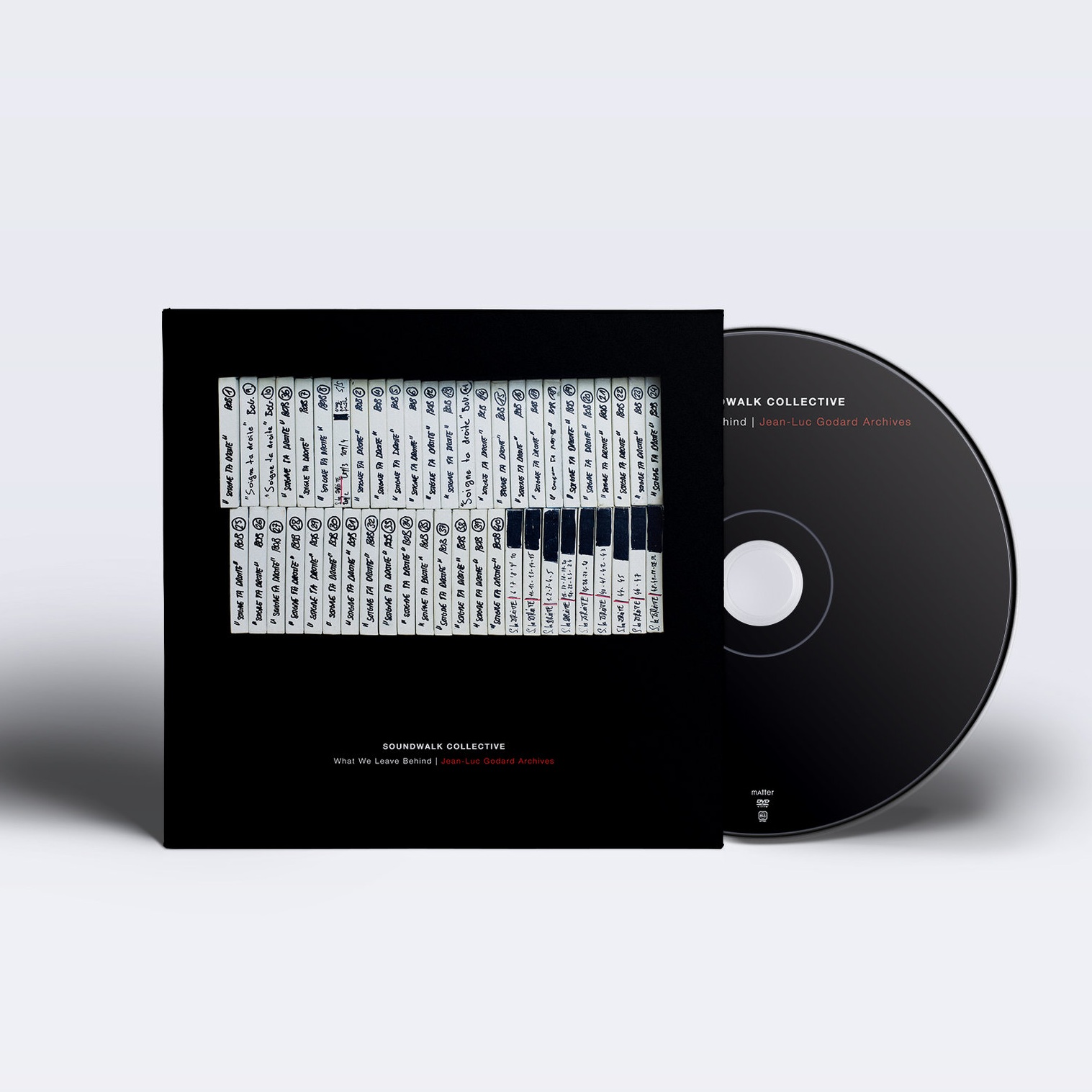SOUNDWALK COLLECTIVE - What we leave Behind / Jean-luc Godard archives
DVD and CASSETTE TAPE ( with Download Card)
SOUNDWALK COLLECTIVE is an experimental sound collective founded by Stephan Crasneanscki in New York City (2000 – present) operating in a continuously rotating constellation of sound artists and musicians.
Their approach to composition combines anthropology, ethnography, non-linear narrative, psycho-geography, the observation of nature, and explorations in recording and synthesis. The source material of their works is always linked to specific locations, natural or artificial, and requires long periods of investigative travel and field work.
Distinguished collaborators include American singer, songwriter and poet Patti Smith, Ethiopian Jazz musician Mulatu Astatke, American photographer Nan Goldin and French-Swiss film director Jean-Luc Godard. The Collective have also written original scores for contemporary dance choreographer Sasha Waltz."
DVD : 44:35
TAPE :
SIDE A: What We Leave Behind - 22:38
SIDE B: What We Leave Behind - 22:11
Realisation: Stephan Crasneanscki
Reel-to-reel Tape Transfer: Simone Merli
Mixed by Tyler Friedman at Sakha Studio, Berlin
Mastered by Stefan Betke at ~Scape Mastering, Berlin
Produced by Soundwalk Collective with Marcus Gammel [Deutschlandradio]
CAT NO : MATTER016
FORMAT : DVD and Cassette Tape (including Download Card)
-
DVD: 44:35 min.
Format: PAL
Region Code: All
This DVD is region free and can be played on any computer (MAC and/or Win.) DVD drive. No region switching is necessary for television screen viewing, it can only play back on a PAL or multi-system DVD player.
*本商品はオリジナル映像作品のデータを元にプレスされている為、マスターデータの都合上、NTSC規格である国内通常のDVDプレイヤー(NTSC)での再生はできません。 MACまたはWindows PCに付属するDVDプレイヤー、またお使いのDVDプレイヤーがNTSC/PAL両対応であれば再生可能ですので、予めご了承下さい。
EDITION : 300copies
PRICE : 3,000 JPYEN
Jean-Luc Godard’s longtime sound engineer, Francois Musy and I drove for 10 hours, from Switzerland, where Godard lives, to Cantal, in France, where the warehouse with his archive is. The idea was to create a sound composition from the recordings in the archive for Deutschlandradio and Radio France Culture. Once in the warehouse, in front of that endless series of boxes full of books, tapes, notes, cut-outs, the full map of his thinking, I felt that all this fragmented material will be the genesis of our sound composition. This is how the idea of What We Leave Behind came about. Sound is its own entity and should be used this way. Each sound has its own value, its own color. The sound of wind rippling through the leaves, a far-off airplane covering a voice, a ringing telephone, a slamming door. Listening to the tapes in Godard’s archive, you could feel this. Some had to be played back on a Studer J37s, the same tape recorder used on Sgt. Pepper’s Lonely Hearts Club Band. Many were full of fragments that didn’t make the final cut, that were never meant to be heard and that now, through this new sound composition, were resurrected. The edits and cuts, the microphone checks, before and after every clap, everything that was left behind, was now a reflection, rather than an omission. They speak to the passing of time. They are timestamps. The question is, when do we stop, when is a story finished, when do we need to stop? In one of the boxes I found some pages of Paul Klee that Godard has underlined in red: “Art plays an unknowing game with the ultimate things and yet reaches them nonetheless! Art does not give the visible but, instead, makes visible”.
Stephan Crasneanscki, 2018
Jean-Luc Godardの長年のサウンドエンジニア、Francois Musyと私は、ゴダールが住んでいるスイスから、彼のアーカイブの倉庫があるフランスのカンタールまで、10時間運転しました。私のアイデアは、DeutschlandradioとRadio France Cultureのアーカイブ内の録音から新しい作品を制作することでした。倉庫に入ったら、本、テープ、メモ、切り欠き、彼の思考の完全な地図でいっぱいの箱にあるその無限のシリーズの前で、私はこれらすべての断片化された材料が私たちの作品になると確信しました。これが、「What We Leave Behid」という考え方が生まれた理由です。音はそれ自身の存在であり、音として使われるべきです。それぞれの音はそれ自身の価値、色を持っています。葉の向こう側に波打つ風の音、声を覆う遠くの飛行機、鳴っている電話、叩いているドア。ゴダールのアーカイブのテープを聞いて、あなたはこれらは感じる事が出来るでしょう。 多くのテープは、Sgt.Pepper's Lonely Hearts Club Bandで使われていたのと同じテープレコーダーであるStuder J37で再生しなければならなかったものもありました。 ここにある多くのテープは最終カットをしなかった断片でいっぱいであり、そしてそれは決してこれまで聴かれることがなかったのですが、今、この新しい作品を通して復活しました。マイクチェックやシューティング前、終わりのクラップ指示を削除する事よりむしろ反映しています。彼らは時間の経過について語っています。それらはタイムスタンプであり、問題は、いつ停止するのか、いつストーリーを終了するのか、いつ停止する必要があるのか、ということです。1つの箱の中に、ゴダールが赤で下線を引いたPaul Kleeの言葉です。“Art plays an unknowing game with the ultimate things and yet reaches them nonetheless! Art does not give the visible but, instead, makes visible”.
Stephan Crasneanscki, 2018



